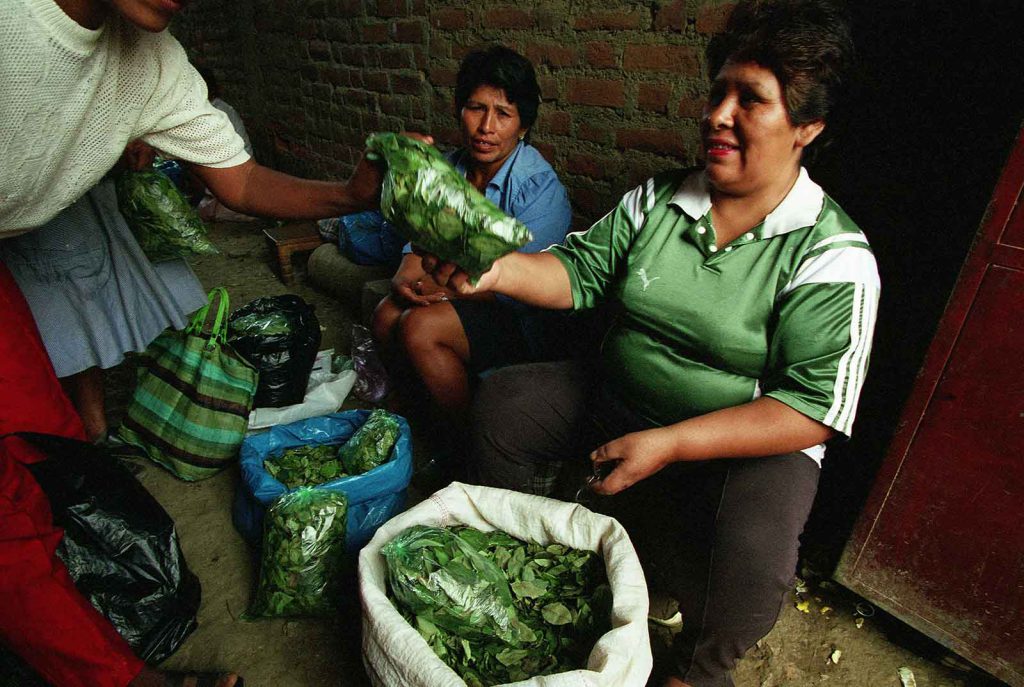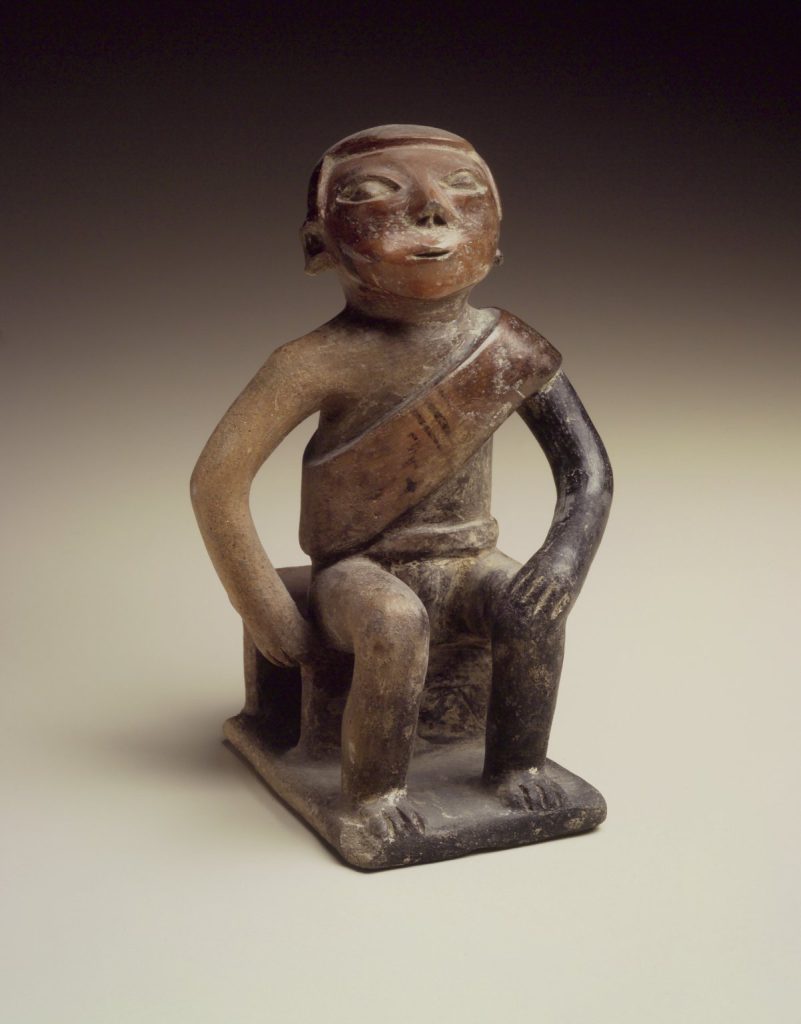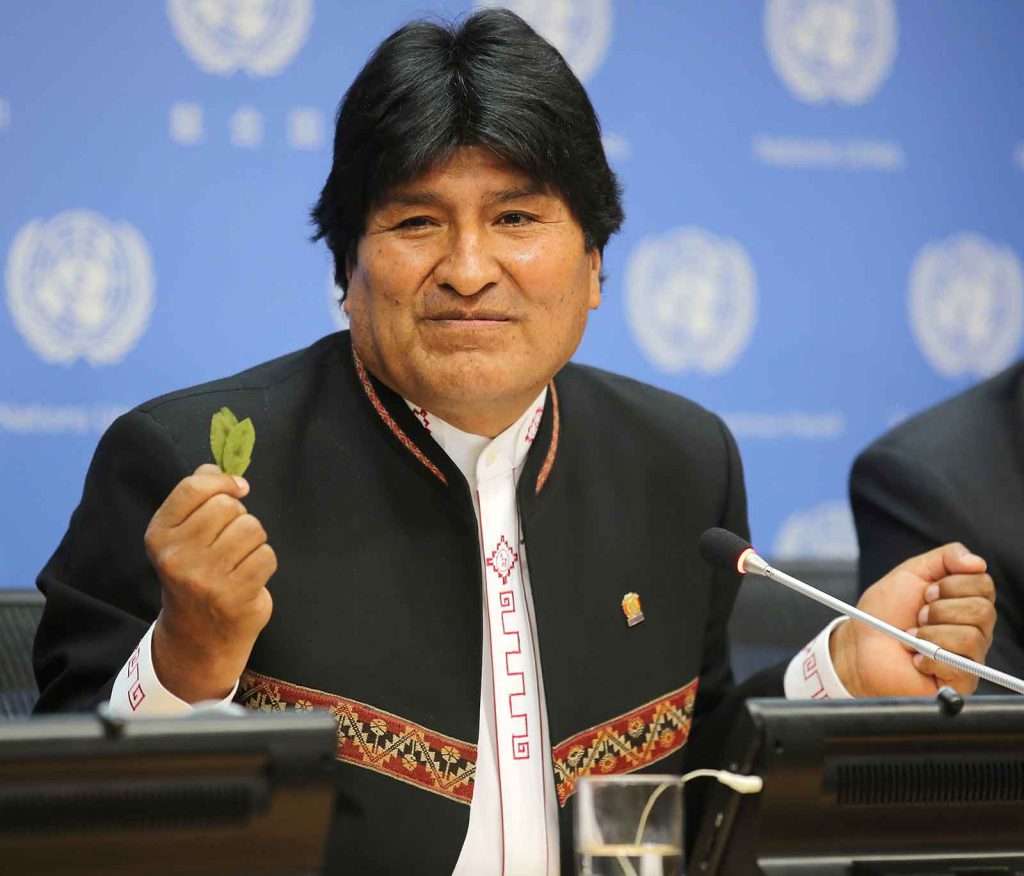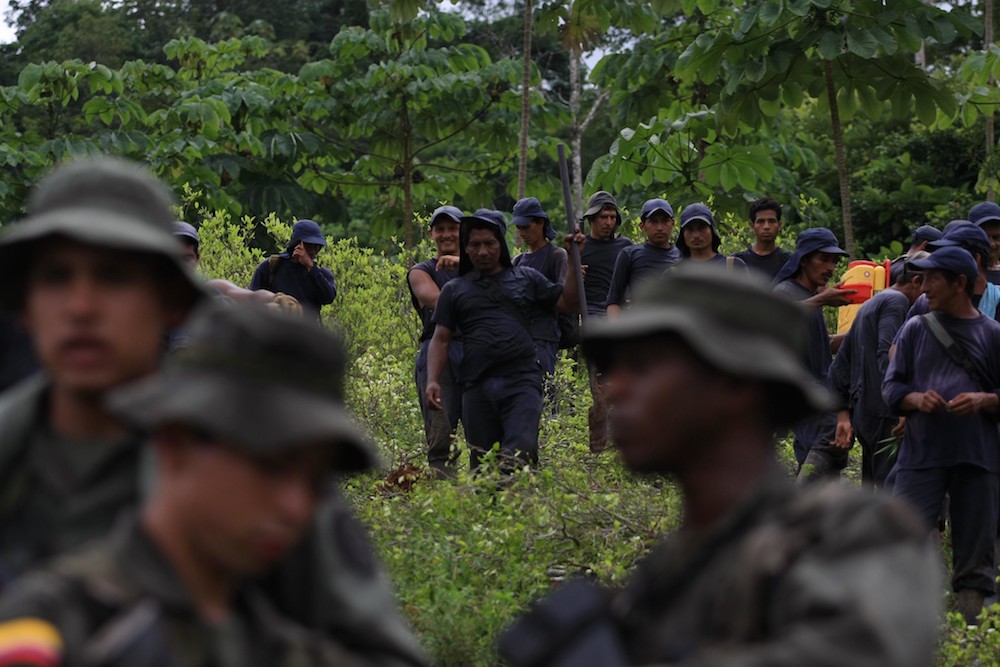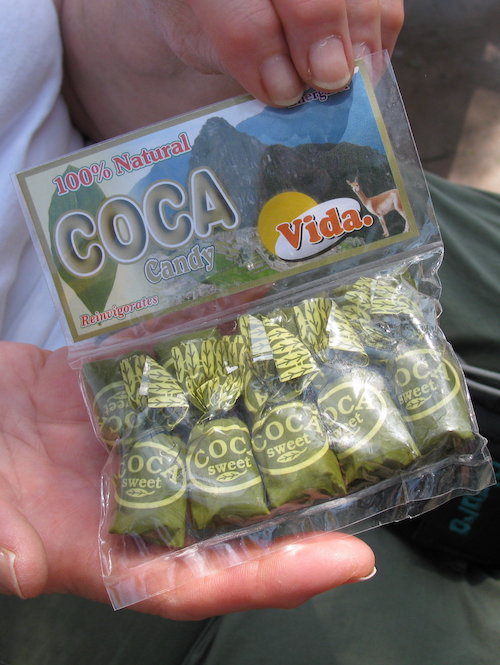The Double Life of Coca
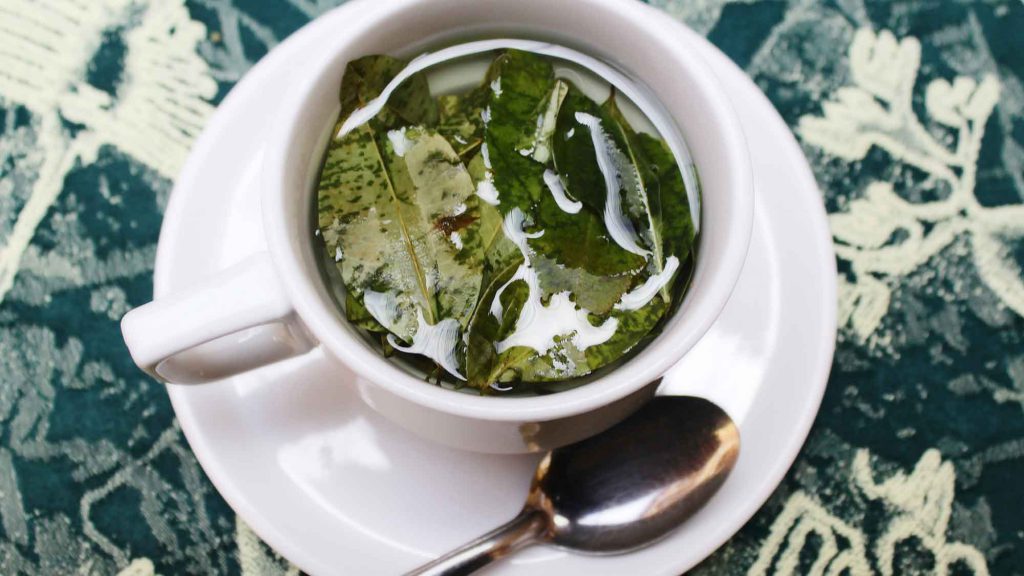
In Peru, people sip tea made of coca leaves—the source of cocaine—like people elsewhere sip Earl Grey. The drink has a bittersweet, grassy flavor similar to a green tea like matcha and is mildly stimulating, like coffee. I have seen coca as an ice cream flavor near Cuzco’s Plaza de Armas and as a candy sold in tourist spots. At Lima’s famed Central restaurant, you can savor bread with smoked coca leaves, washed down with a coca-infused pisco sour.
Throughout the Andean countries, coca has been cultivated and consumed for thousands of years as a medicine, an element in religious rituals, and an energy booster for laborers. It is traditionally chewed with an alkaline ingredient, similar to tobacco chewing in the Americas and betel chewing in parts of Asia. “It’s good for the altitude,” my hiking guide told me in Spanish as we trekked up the 5,822-meter El Misti volcano.
“Just don’t bring it home,” my Peruvian friend Leonardo Porras said. “You could get in trouble.”
In my case, home is the Philippines. But Porras could have been referring to almost any country in the world, because outside of a few South American nations, possession of coca leaf, even for brewing tea, is illegal. While coca tea has the status of chamomile in Colombia, in most parts of the world it has the same legal standing as cocaine or methamphetamine. And it carries with it the same negative attitudes many people have about illegal drugs.
This discrepancy raises a dilemma among Andean countries: How can you reconcile cultivating a leaf that’s both a traditional beverage and the precursor to one of the most widely used illicit drugs in the world?
As an anthropologist who studies substance use patterns and policies around the world, I have examined various approaches to this issue. Some say decriminalization is the answer because the violence and crime associated with the cocaine trade have much to do with its illegality. Some insist only eradicating coca and continuing to outlaw cocaine can solve the “drug problem,” even though the decades-long “war on drugs” based on this paradigm has failed. Others advocate for a middle ground in which limited amounts of coca could be grown for traditional use locally and sold on the international market.
The world’s largest producers of coca—Peru, Colombia, and Bolivia—have experimented with these various strategies. The results are revealing and complicated. To determine how countries might better navigate the future of coca and cocaine, it’s essential to explore the plant’s controversial past and present.
Coca’s stimulating history stretches back at least 8,000 years, when societies in what is today Peru chewed the leaves treated with calcite to enhance their invigorating effects. The shrub continued to play an important role in the 15th and 16th centuries during the Inca Empire, figuring in religious ceremonies and Indigenous pharmacopoeias. In Argentina, the mummified bodies of children sacrificed during capacocha ceremonies reveal they consumed high amounts of coca in the year before their deaths.
Voyagers, chroniclers, and conquistadores sent word to Europe about this miracle plant. Jesuit historian Padre Blas Valera was quoted in 1606 as saying, “Coca … is so agreeable to the Indians that they prefer it above gold, silver, and precious stones.” It is used, he reported, to “reduce the swelling of wounds, to strengthen broken bones, to expel cold from the body or prevent it from entering, and to cure rotten wounds.”
Because of coca’s links to Indigenous religious ceremonies and cultural practices, Catholic priests and other colonists attempted to outlaw its use as early as the 16th century. But commercial motivations prevailed. The Spanish instead sought to profit from coca, taxing and trading the leaf while rationing it to the laborers who claimed it boosted their strength, alleviated their hunger, and relieved their pain. In many ways, the chewing of coca foreshadowed the use of energy drinks, coffee, and methamphetamines by today’s workers to help them cope with their labors.
During the rise of modern pharmacology in Europe in the 19th century, chemists isolated coca’s main organic compound, cocaine. This discovery would lead to an entirely new use for the coca leaf: as the raw ingredient for cocaine—a far more potent drug in its own right.
At first, cocaine was used as an anesthetic (hence the suffix -aine, like “lidocaine”) during surgery. Then its medical indications expanded in the late 1800s, when it was touted as a panacea. Physician Sigmund Freud reported experiencing “exhilaration and lasting euphoria” while taking the drug and devoted an entire treatise to it. Explorer Ernest Shackleton and his team brought cocaine to Antarctica as a purported remedy for snow blindness and a stimulant during the arduous trek to the South Pole.
In the U.S., people could buy cocaine over the counter until 1914. The substance was mixed into numerous drinks, such as wine and Coca-Cola, which is still flavored with decocainized coca leaves. These products became popular not just because of their reported medical benefits but because of the coca leaf’s romanticized Incan provenance.
While cocaine is one of the world’s most addictive and damaging substances, coca is not associated with harmful dependence.
Cocaine’s addictive potential, however, was soon recognized. At the turn of the 20th century, much of the world was gripped by a moral panic about drugs. Worldwide controls such as the International Opium Convention in 1925 soon followed, leading to a decline in the coca planting industry.
The 1961 Single Convention on Narcotic Drugs—perhaps the most influential document to shape global drug policy—called for the destruction of coca plants and the abolition of coca chewing within 25 years. The document classified both cocaine and coca leaves as Schedule I drugs, meaning they are liable to be abused and must be strictly controlled.
Then, as now, governments of Andean countries have rejected the nearly worldwide ban on coca. They argue that Indigenous peoples have been safely consuming coca for thousands of years. They seek to distinguish the leaf from its infamous powdery extract because, in fact, the two are strikingly different.
In 2009, Bolivia’s then-President Evo Morales stood in front of a United Nations meeting and dramatically chewed coca. “The coca leaf in its natural state is not harmful to health,” he declared in Spanish. “Not only do I say that as a producer of the coca leaf … but as a consumer of the coca leaf in its natural state.”
Coca leaves contain between 0.5 and 1 percent cocaine, so it takes about 450 to 600 kilograms of fresh leaves to make 1 kilogram of cocaine. Transforming the leaves into cocaine involves a multistep process of dissolution, extraction, and purification using some combination of lime (in the form of cement mix), sulfuric acid, kerosene, gasoline, ammonia, hydrochloric acid, acetone (the active ingredient in paint thinner), and other dangerous chemicals.
While cocaine is one of the world’s most addictive and damaging substances, coca is not associated with harmful dependence. Some researchers even consider it “physiologically beneficial” in helping people cope with high altitudes and for providing valuable vitamins and nutrients.
Still, though some coca planted in Peru is used for traditional and medicinal purposes, a shocking 89.7 percent ends up as raw material in the international drug trade. In addition, the legal market furnishes the justification for the existence of the illegal market. So how can governments support the safe consumption of coca and the producers who have grown the plant for generations, while curbing the detrimental effects of the cocaine trade?
For many years, forced eradication of coca—supported and financed by the U.S.—has been the dominant policy in South America. But this approach has wreaked havoc on poor farmers and their communities in Colombia, Peru, and Bolivia. Anthropologist Thomas Grisaffi reports that militarized teams in those countries have burned homesteads and killed, abused, tortured, and jailed hundreds of coca farmers and other people who have been cast as the “enemy.”
The strictest anti-coca laws are in Colombia, where the government has destroyed farmsteads and fumigated more than half a million hectares of plantations. According to anthropologist María Clemencia Ramírez, these herbicides have triggered health problems among local residents, contaminated the water, and degraded land where food crops grow.
Yet because farmers have few viable alternatives to growing coca, they merely move their farms deeper into the jungles. As a result, coca cultivation in Colombia continues to rise.
Peru’s drug policies have largely emulated these regional trends, despite protests from coca farmers and intermittent openness on the part of the government to alternative paradigms that recognize the farmers’ legitimacy. Still, the country continues to use forced elimination as part of its plan to wipe out 25,000 hectares of coca plantations per year by 2021. Last year, one of these operations sparked violent clashes. And despite these efforts, coca production in Peru is expanding.
As a complement to eradication, organizations such as the United Nations and the United States Agency for International Development encourage “alternative development,” which incentivizes farmers to shift from coca to other crops. But Grisaffi says this strategy has not proven viable for the region’s farmers, who often live in extreme poverty. Many food crops require a huge initial investment, take years to mature, and/or fetch a low price at the market. So, farmers return to coca, which is more lucrative. Even coffee growers, faced with steep price declines due to a bumper crop of Brazilian coffee beans, have reportedly switched to coca.
Alternatively, some organizations and individuals say both coca and cocaine should be decriminalized to reduce the violence and illicit economies associated with the illegal trade. Decriminalization advocates point out that punitive measures disproportionately impact the poor without decreasing coca production. Many policy experts champion harm reduction, which calls for ameliorating the negative impact of drugs on individuals and society instead of demonizing all such substances as “evil.”
Bolivia has adopted a strategy that implements both harm reduction and the decriminalization of coca. It operates under Morales’ motto, “Coca yes, cocaine no.”
In 2006, Bolivia abandoned the U.S.-backed model of militarized eradication in favor of a community-based social control program that allows farmers to grow coca in limited amounts. The initiative prioritizes the welfare of coca-growing communities by involving farmers in decision-making and granting them formal property rights. Local farmer unions monitor compliance, and farmers are motivated to keep production low so prices stay high. Thus, enforcement is not associated with violence or human rights abuses.
The government has also invested in infrastructure, health care, and education within coca-growing regions, and in developing coca products, such as flour and toothpaste. This has boosted economic security in the region and is allowing growers to diversify their sources of income.
Most significantly, since this model was implemented, coca production has steadily declined in Bolivia, suggesting progress has been made in the government’s goal of limiting the leaf’s cultivation to traditional purposes.
Bolivia’s approach does not come without problems: Many coca growers struggle financially, debates simmer over how regulations should be enforced, and the program’s future is unclear under the country’s new government. What’s more, experts acknowledge the initiative may be difficult to replicate outside of Bolivia because it relies on robust unions and community organizations that other countries lack.
Still, the case studies of Bolivia, Peru, and Colombia offer valuable clues as to which strategies might succeed in addressing the dilemma of coca and cocaine, as well as other controversial substances around the world.
This article was republished on Discovermagazine.com.
































